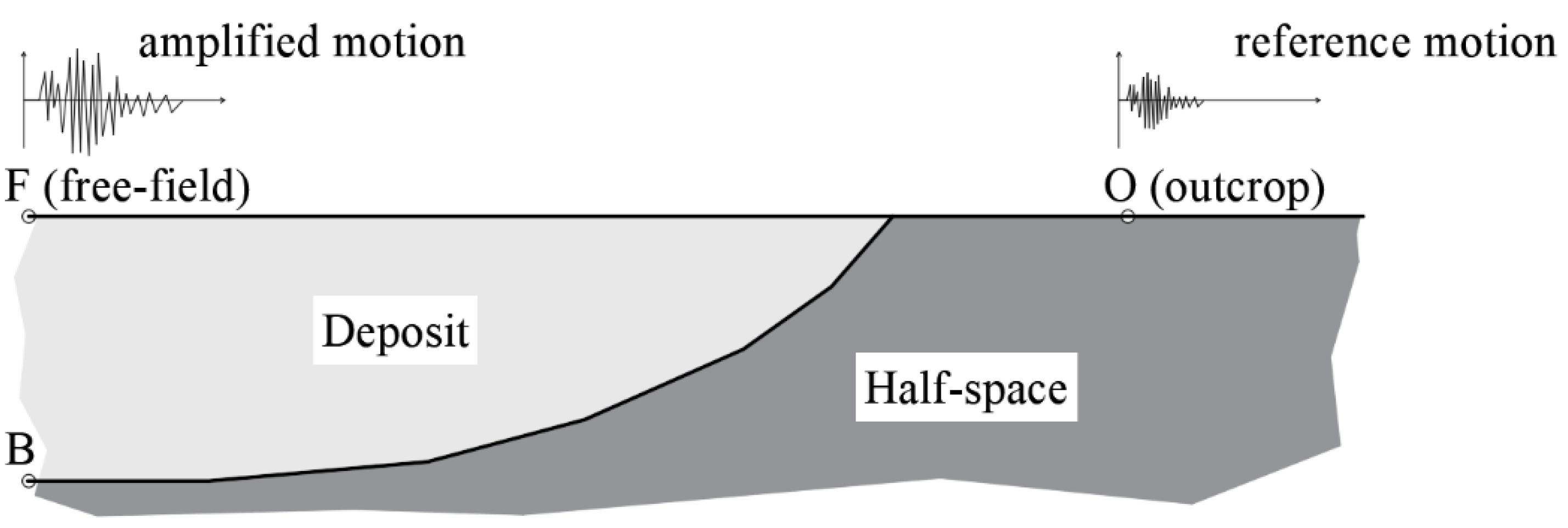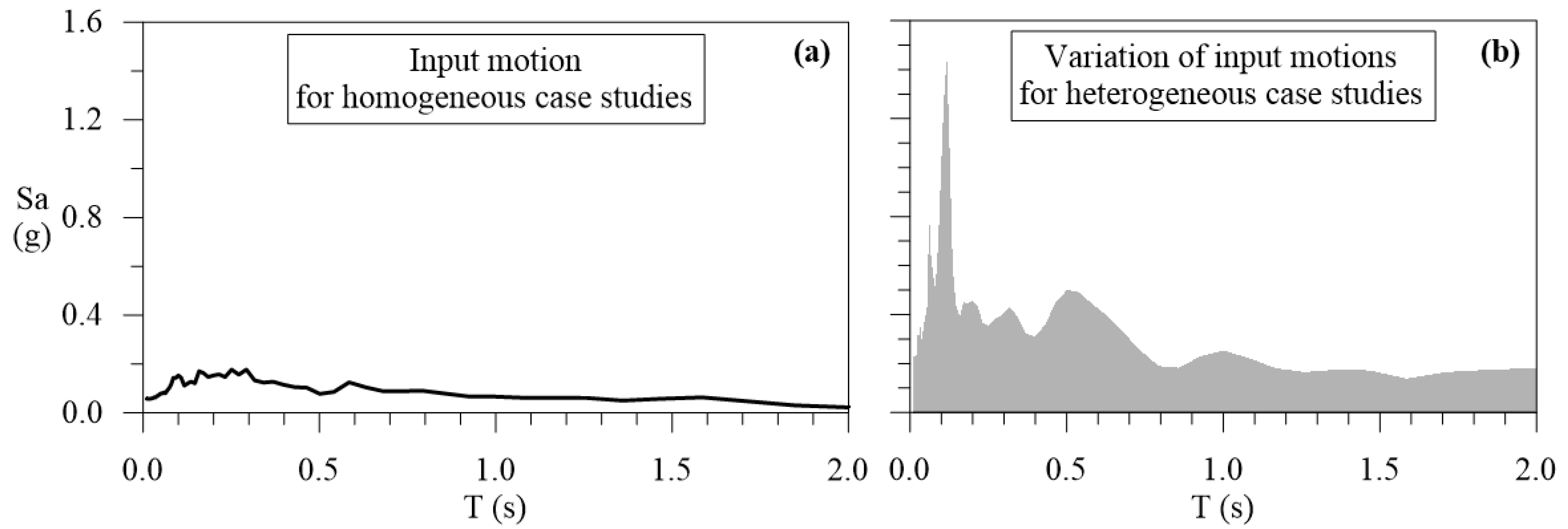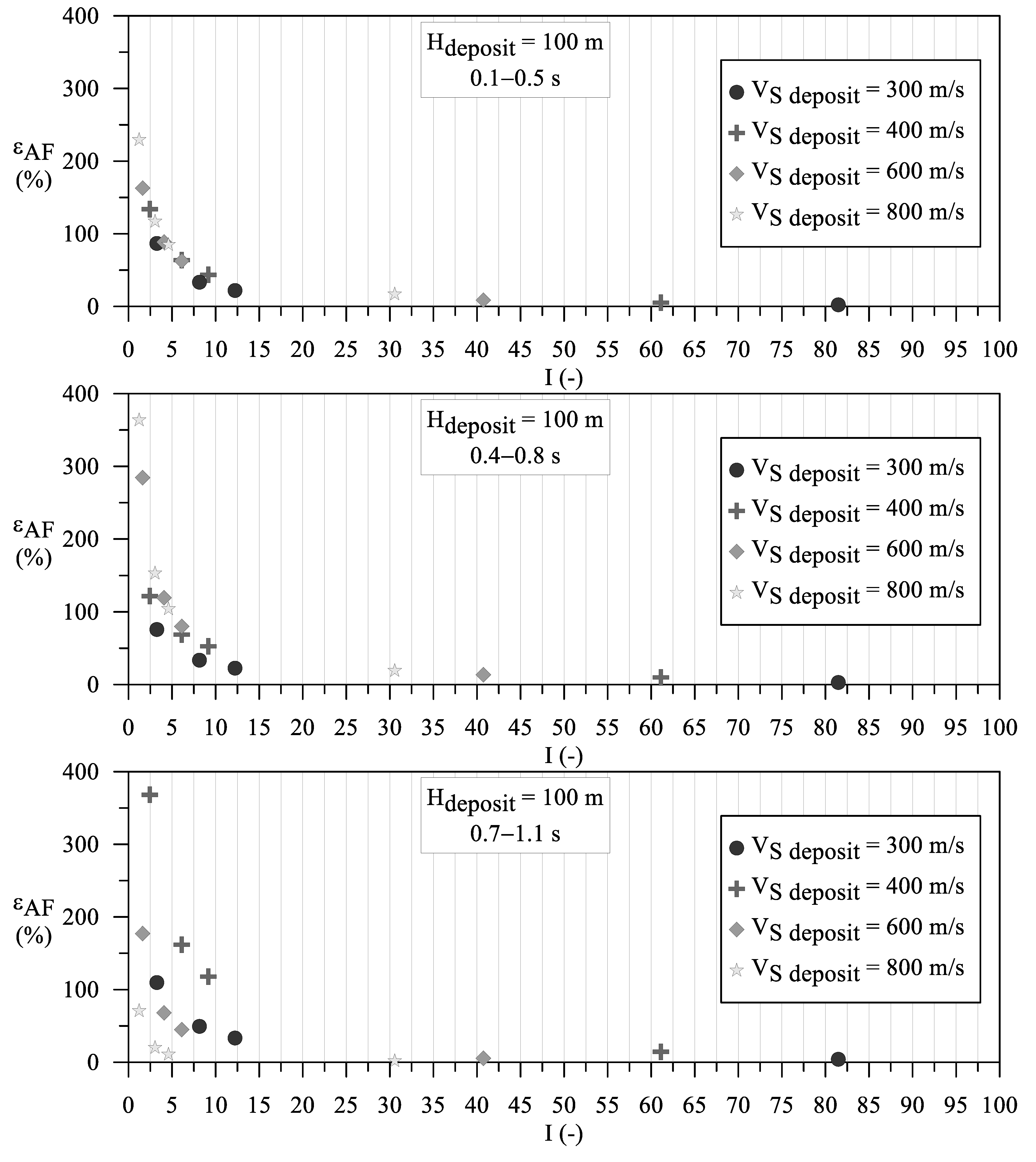Effect of Base Conditions in One-Dimensional Numerical Simulation of Seismic Site Response: A Technical Note for Best Practice
Abstract
:1. Introduction
2. Numerical Modelling of Seismic Site Response
2.1. Homogenous Deposit
2.2. Heterogenous Case Studies
3. Conclusions
- -
- The higher the impedance ratio between the deposit and the half-space (i.e., the base of the numerical model) the lower the error. In detail, the rigid and elastic base results agree for impedance contrasts higher than 30;
- -
- Referring to shallow deposits (thickness lower than 30 m), the higher the range of periods of interest, the lower the overestimation of the rigid base models, with respect to the elastic base ones;
- -
- Referring to deep deposits (thickness higher than 100 m), the higher the range of periods of interest, the higher the overestimation of the rigid base models with respect to the elastic base ones.
Author Contributions
Funding
Institutional Review Board Statement
Informed Consent Statement
Data Availability Statement
Acknowledgments
Conflicts of Interest
References
- Kramer, S. Geotechnical Earthquake Engineering; Prentice Hall: Upper Saddle River, NJ, USA, 1996; ISBN 9780133749434. [Google Scholar]
- Moczo, P.; Kristek, J.; Bard, P.Y.; Stripajová, S.; Hollender, F.; Chovanová, Z.; Kristeková, M.; Sicilia, D. Key structural parameters affecting earthquake ground motion in 2D and 3D sedimentary structures. Bull. Earthq. Eng. 2018, 16, 2421–2450. [Google Scholar] [CrossRef] [Green Version]
- Makra, K.; Chávez-García, F.J.; Raptakis, D.; Pitilakis, K. Parametric analysis of the seismic response of a 2D sedimentary valley: Implications for code implementations of complex site effects. Soil Dyn. Earthq. Eng. 2005, 25, 303–315. [Google Scholar] [CrossRef]
- Falcone, G.; Acunzo, G.; Mendicelli, A.; Mori, F.; Naso, G.; Peronace, E.; Porchia, A.; Romagnoli, G.; Tarquini, E.; Moscatelli, M. Seismic amplification maps of Italy based on site-specific microzonation dataset and one-dimensional numerical approach. Eng. Geol. 2021, 289, 106170. [Google Scholar] [CrossRef]
- Rathje, E.M.; Kottke, A.R.; Trent, W.L. Influence of input motion and site property variabilities on seismic site response analysis. J. Geotech. Geoenviron. Eng. 2010, 136, 607–619. [Google Scholar] [CrossRef]
- Guzel, Y.; Rouainia, M.; Elia, G. Effect of soil variability on nonlinear site response predictions: Application to the Lotung site. Comput. Geotech. 2020, 121, 103444. [Google Scholar] [CrossRef]
- Régnier, J.; Bonilla, L.; Bard, P.; Bertrand, E.; Hollender, F.; Kawase, H.; Sicilia, D.; Arduino, P.; Amorosi, A.; Asimaki, D.; et al. PRENOLIN: International Benchmark on 1D Nonlinear Site-Response Analysis—Validation Phase Exercise. Bull. Seismol. Soc. Am. 2018, 108, 876–900. [Google Scholar] [CrossRef]
- Falcone, G.; Romagnoli, G.; Naso, G.; Mori, F.; Peronace, E.; Moscatelli, M. Effect of bedrock stiffness and thickness on numerical simulation of seismic site response. Italian case studies. Soil Dyn. Earthq. Eng. 2020, 139, 106361. [Google Scholar] [CrossRef]
- Talukder, M.K.; Rosset, P.; Chouinard, L. Reduction of Bias and Uncertainty in Regional Seismic Site Amplification Factors for Seismic Hazard and Risk Analysis. GeoHazards 2021, 2, 277–301. [Google Scholar] [CrossRef]
- Callisto, L.; Rampello, S.; Viggiani, G.M.B. Soil–structure interaction for the seismic design of the Messina Strait Bridge. Soil Dyn. Earthq. Eng. 2013, 52, 103–115. [Google Scholar] [CrossRef] [Green Version]
- Falcone, G.; Boldini, D.; Amorosi, A. Site response analysis of an urban area: A multi-dimensional and non-linear approach. Soil Dyn. Earthq. Eng. 2018, 109, 33–45. [Google Scholar] [CrossRef]
- Falcone, G.; Boldini, D.; Martelli, L.; Amorosi, A. Quantifying local seismic amplification from regional charts and site specific numerical analyses: A case study. Bull. Earthq. Eng. 2020, 18, 77–107. [Google Scholar] [CrossRef]
- Régnier, J.; Bonilla, L.; Bard, P.; Bertrand, E.; Hollender, F.; Kawase, H.; Sicilia, D.; Arduino, P.; Amorosi, A.; Asimaki, D.; et al. International Benchmark on Numerical Simulations for 1D, Nonlinear Site Response (PRENOLIN): Verification Phase Based on Canonical Cases. Bull. Seismol. Soc. Am. 2016, 106, 2112–2135. [Google Scholar] [CrossRef]
- Mejia, L.H.; Dawson, E.M. Earthquake deconvolution for FLAC. In Proceedings of the 4th International FLAC Symposium on Numerical Modeling in Geomechanics, Madrid, Spain, 29–31 May 2006; Itasca Consulting Group: Minneapolis, MN, USA, 2006. [Google Scholar]
- DPC. Dipartimento della Protezione Civile Commissione Tecnica per il Supporto E Monitoraggio Degli Studi di Microzonazione Sismica (ex art.5, OPCM3907/10), (2018)—WebMs; WebCLE. A cura di: Maria Sole Benigni, Fabrizio Bramerini, Gianluca Carbone, Sergio Castenetto, Gian Paolo Cavinato, Monia Coltella, Margherita Giuffrè, Massimiliano Moscatelli, Giuseppe Naso, Andrea Pietrosante, Francesco Stigliano. 2018; Available online: www.webms.it (accessed on 01 February 2021).
- Gaudiosi, I.; Simionato, M.; Mancini, M.; Cavinato, G.P.; Coltella, M.; Razzano, R.; Sirianni, P.; Vignaroli, G.; Moscatelli, M. Evaluation of site effects at Amatrice (central Italy) after the 24th August 2016, Mw 6.0 earthquake. Soil Dyn. Earthq. Eng. 2021, 144, 106699. [Google Scholar] [CrossRef]
- Giallini, S.; Pizzi, A.; Pagliaroli, A.; Moscatelli, M.; Vignaroli, G.; Sirianni, P.; Mancini, M.; Laurenzano, G. Evaluation of complex site effects through experimental methods and numerical modelling: The case history of Arquata del Tronto, central Italy. Eng. Geol. 2020, 272, 105646. [Google Scholar] [CrossRef]
- Moscatelli, M.; Albarello, D.; Scarascia Mugnozza, G.; Dolce, M. The Italian approach to seismic microzonation. Bull. Earthq. Eng. 2020, 18, 5425–5440. [Google Scholar] [CrossRef]
- Falcone, G.; Mendicelli, A.; Mori, F.; Fabozzi, S.; Moscatelli, M.; Occhipinti, G.; Peronace, E. A simplified analysis of the total seismic hazard in Italy. Eng. Geol. 2020, 267, 105511. [Google Scholar] [CrossRef]
- ITACA. ITalian ACcelerometric Archive. Retrieved April, 2020.. 2019. Available online: http://itaca.mi.ingv.it/ItacaNet_30/#/home (accessed on 01 February 2021).
- Luzi, L.; Pacor, F.; Puglia, R. Italian Accelerometric Archive v3.0. Istituto Nazionale di Geofisica e Vulcanologia; Dipartimento della Protezione Civile Nazionale: Rome, Italy, 2001. [Google Scholar] [CrossRef]
- Kottke, A.; Wang, X.; Rathje, E.M. Technical Manual for Strata. Rep. No. 2008/10; Pacific Earthquake Engineering Research Center: Berkeley, CA, USA, 2013. [Google Scholar]
- Schnabel, P.B.; Lysmer, J.; Seed, H.B. Shake: A Computer Program for Earthquake Response Analysis of Horizontally-Layered sites; Technical Report EERC-72/12; Earthquake Engineering Research Centre, University of California: Berkeley, CA, USA, 1972. [Google Scholar]
- Idriss, M.; Sun, J.I. SHAKE91: A Computer Program for Conducting Equivalent Linear Seismic Response Analyses of Horizontally Layered Soil Deposits; Centre for Geotechnical Modelling, Department of Civil and Environmental Engineering, University of California: Davis, CA, USA, 1992. [Google Scholar]
- Darendeli, M.B. Development of a New Family of Normalized Modulus Reduction and Material Damping Curves; University of Texas: Austin, TX, USA, 2001. [Google Scholar]








| H | VS | f0 | T0 |
|---|---|---|---|
| (m) | (m/s) | (Hz) | (s) |
| 15 | 300 | 5.00 | 0.20 |
| 15 | 400 | 6.67 | 0.15 |
| 15 | 600 | 10.00 | 0.10 |
| 15 | 800 | 13.33 | 0.08 |
| 100 | 300 | 0.75 | 1.33 |
| 100 | 400 | 1.00 | 1.00 |
| 100 | 600 | 1.50 | 0.67 |
| 100 | 800 | 2.00 | 0.50 |
Publisher’s Note: MDPI stays neutral with regard to jurisdictional claims in published maps and institutional affiliations. |
© 2021 by the authors. Licensee MDPI, Basel, Switzerland. This article is an open access article distributed under the terms and conditions of the Creative Commons Attribution (CC BY) license (https://creativecommons.org/licenses/by/4.0/).
Share and Cite
Falcone, G.; Naso, G.; Mori, F.; Mendicelli, A.; Acunzo, G.; Peronace, E.; Moscatelli, M. Effect of Base Conditions in One-Dimensional Numerical Simulation of Seismic Site Response: A Technical Note for Best Practice. GeoHazards 2021, 2, 430-441. https://doi.org/10.3390/geohazards2040024
Falcone G, Naso G, Mori F, Mendicelli A, Acunzo G, Peronace E, Moscatelli M. Effect of Base Conditions in One-Dimensional Numerical Simulation of Seismic Site Response: A Technical Note for Best Practice. GeoHazards. 2021; 2(4):430-441. https://doi.org/10.3390/geohazards2040024
Chicago/Turabian StyleFalcone, Gaetano, Giuseppe Naso, Federico Mori, Amerigo Mendicelli, Gianluca Acunzo, Edoardo Peronace, and Massimiliano Moscatelli. 2021. "Effect of Base Conditions in One-Dimensional Numerical Simulation of Seismic Site Response: A Technical Note for Best Practice" GeoHazards 2, no. 4: 430-441. https://doi.org/10.3390/geohazards2040024
APA StyleFalcone, G., Naso, G., Mori, F., Mendicelli, A., Acunzo, G., Peronace, E., & Moscatelli, M. (2021). Effect of Base Conditions in One-Dimensional Numerical Simulation of Seismic Site Response: A Technical Note for Best Practice. GeoHazards, 2(4), 430-441. https://doi.org/10.3390/geohazards2040024






